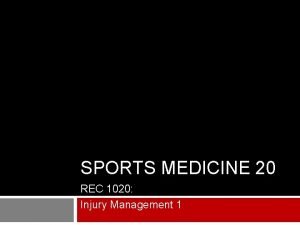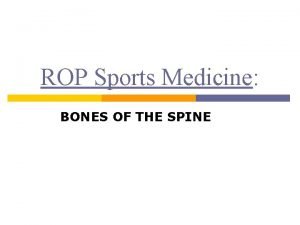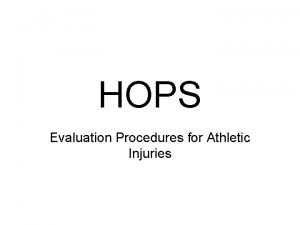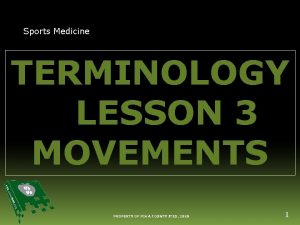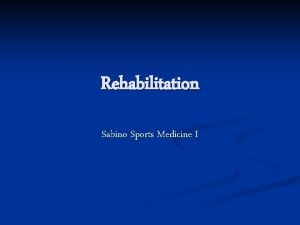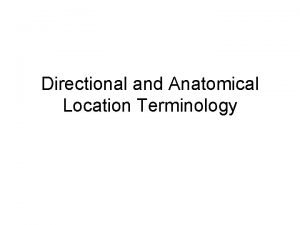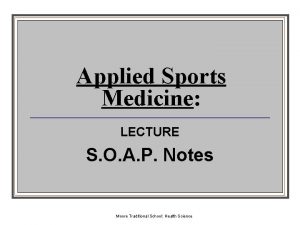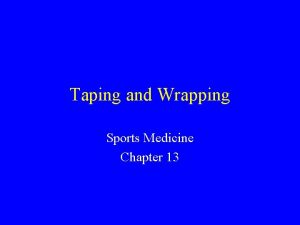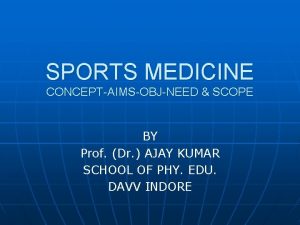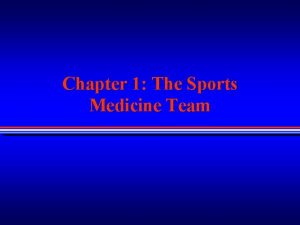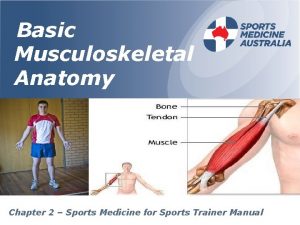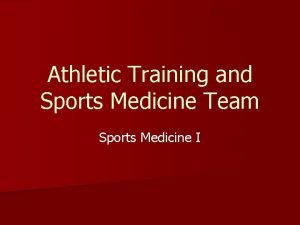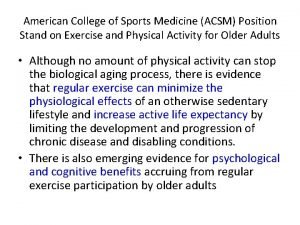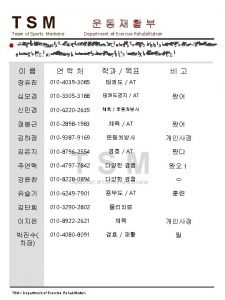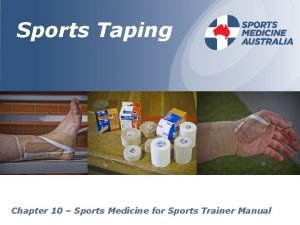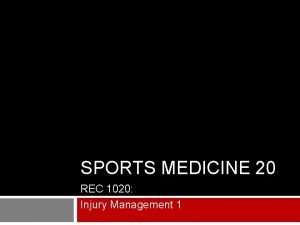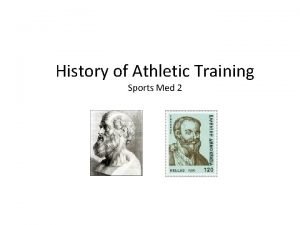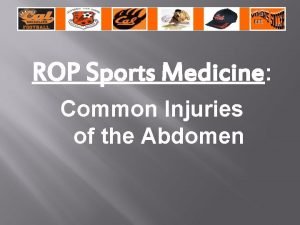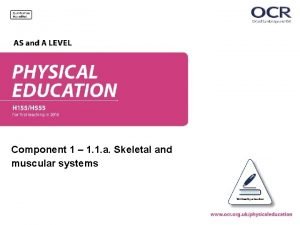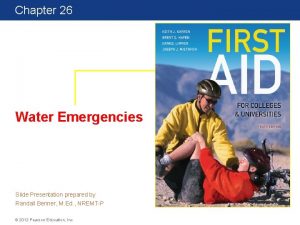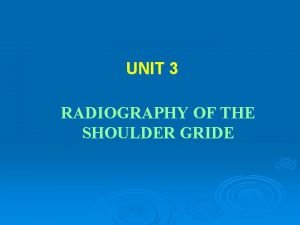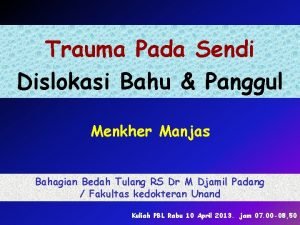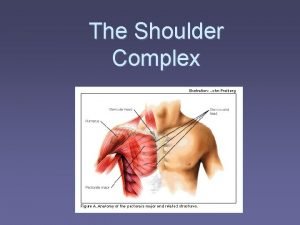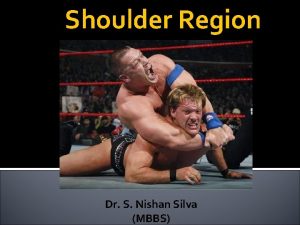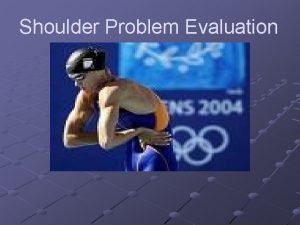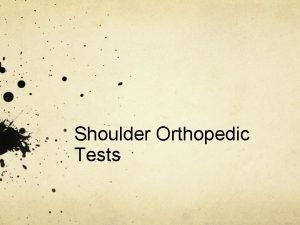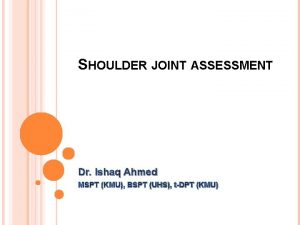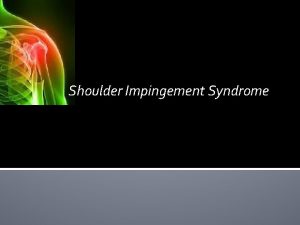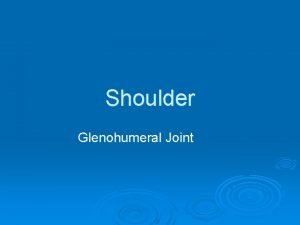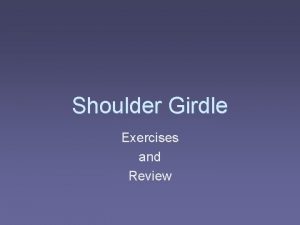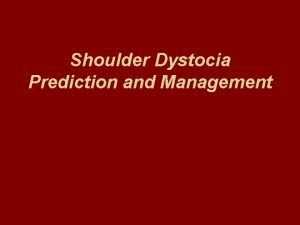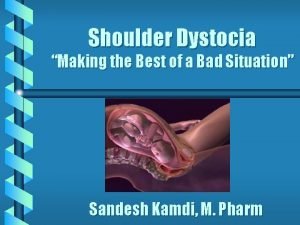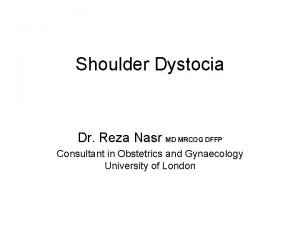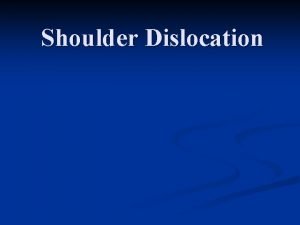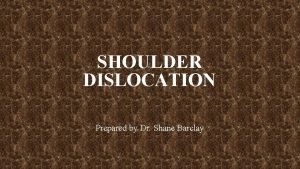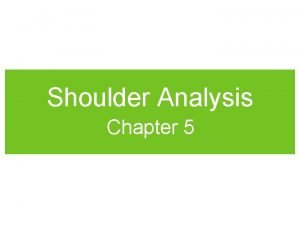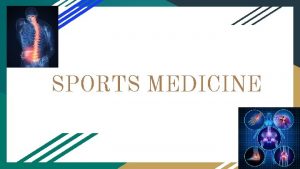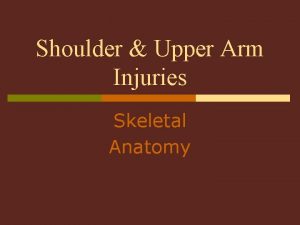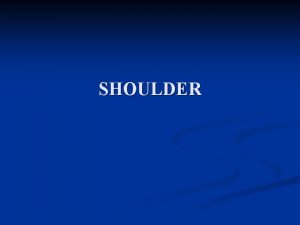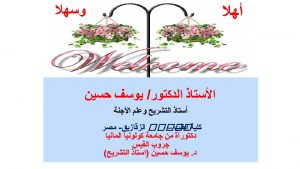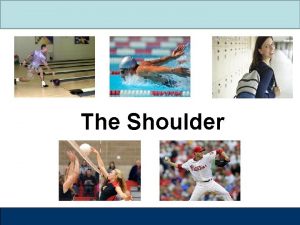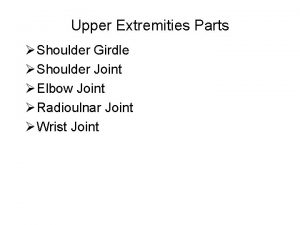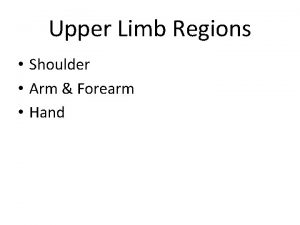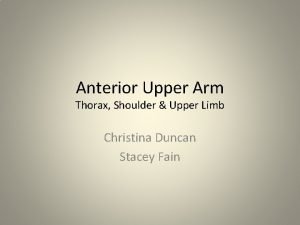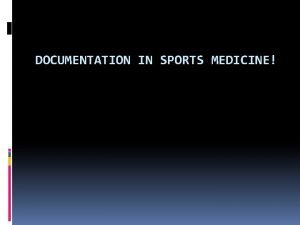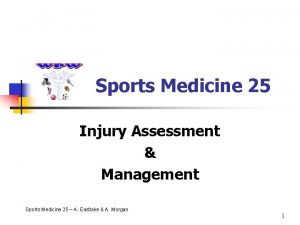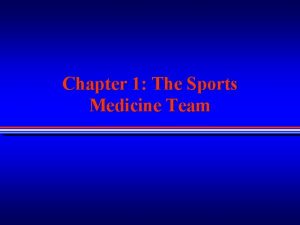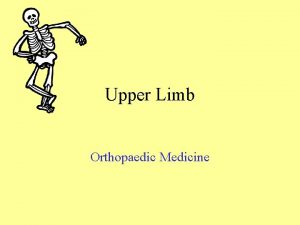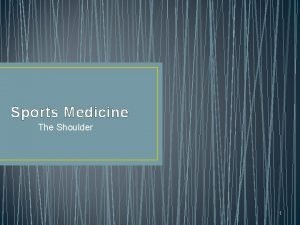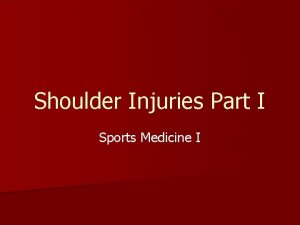Sports Medicine I Ch 11 Shoulder and Upper
















































- Slides: 48

Sports Medicine I Ch. 11 Shoulder and Upper Arm

Objectives Standards – 2. 2, 2. 6, 2. 8, 5. 5, 6. 1, 6. 4, 6. 6, 6. 7 1. 2. 3. 4. 5. 6. SWBAT label the bones of the shoulder and upper arm SWBAT label the joints of the shoulder and upper arm SWBAT label the muscles of the shoulder and upper arm and state their action SWBAT label the arteries of the shoulder and upper arm SWBAT measure the ROM of the shoulder and upper arm SWBAT demonstrate special tests of the shoulder and upper arm and state the purpose of each 7. SWBAT define common injuries of the shoulder and upper arm 8. SWBAT describe treatments used for common injuries of the shoulder and upper arm 9. SWBAT describe protective devices used for common injuries of the shoulder and upper arm 10. SWBAT demonstrate taping and wrapping techniques for the shoulder and upper arm and state the Purpose, Position, and Procedure for each

Bones

Bones o Clavicle is commonly known as the collarbone o Scapula is commonly know as the shoulder blade o Acromion – part of the scapula o Coracoid Pricess– part of the scapula

Shoulder Joints There are 5 joints that make up the shoulder complex 1. Glenohumeral (GH) joint – a ball-and-socket joint. The head of the humerus is the ball and the socket in the scapula is called the glenoid fossa 2. Sternoclavicular (SC) joint – connects the sternum and the clavicle 3. Acromioclavicular (AC) joint – connects the clavicle and the acromion process of the scapula 4. Coracoclavicular (CC) joint – connects the clavicle and the coracoid process of the scapula 5. Thoracoscapular (TS) joint – the scapula gliding on the ribs See the pictures on the next slide

Joints

Ligaments and Labrum (cartilage)

Circulation Axillary Artery/Brachial Artery

Circulation Subclavian/Axillary/Brachial Artery

Arteries The 3 main areas of the artery are the 1. Subclavian – where the artery passes under the clavicle 2. Axillary – in the armpit (axilla) area 3. Brachial – along the humerus The artery is one continuous vessel – the names just refer to different sections of the artery

Muscles Rotator Cuff

Rotator Cuff The 4 rotator cuff muscles are called the SITS muscles 1. Supraspinatus 2. Infraspinatus 3. Teres Minor 4. Subscapularis They rotate the arm and stabilize the humerus in the glenoid fossa

Muscles Anterior View Pectoralis Major

Muscles Anterior View

Muscles Anterior View – Pectoralis Minor

Muscles Anterior View - Coracobrachialis

Muscles Posterior View

Muscles Posterior View

Muscles Posterior View

Shoulder ROM o o o o Flexion – movement of the arms upward toward the front of the body Extension – movement of the arms backward towards the rear of the body Abduction – movement of the arms away from the body Adduction – movement of the arms back towards the body Horizontal Abduction – with the arms flexed towards the front of the body and parallel to the ground, the arms are moved away from the midline of the body Horizontal Adduction – with the arms abducted away from the sides of the body and parallel to the ground, the arms are moved towards the midline of the body and towards the front of the body Internal Rotation in Adduction- with the arm at the side and elbow flexed to 90°, the hand is moved toward the stomach Internal Rotation in Abduction- with the arm abducted to 90° and elbow flexed to 90°, the hand is moved toward the floor External Rotation in Adduction- with the arm at the side and elbow flexed to 90°, the hand is moved away from the stomach External Rotation in Abduction- with the arm abducted to 90° and elbow flexed to 90°, the hand is moved toward the ceiling Circumduction – a full circular movement at the shoulder joint Elevation – movement of the shoulder upwards the ear (shrug) Depression - movement of the shoulder downwards to the normal posture Protraction – movement of the shoulder blades away from each other Retraction – movement of the shoulder blades towards each other

Common Injuries Winged Scapula MOI – contusion or damage to long thoracic nerve, weak serratus anterior muscle Tx – rehab program, consult neurologist if nerve is damaged

Common Injuries Impingement – bursa or rotator cuff tendon MOI – poor scapula motion, hooked acromion, overuse Tx – rest or decreased activity, correct technique, US, cryotherapy, NSAIDS, proprioception.

Common Injuries Bursitis – inflammation of the bursa sac MOI – direct blow, impingement of subacromial space Tx – US, ice, protection, aspiration, correct scapular mechanics

Common Injuries Tendinitis/Tenosynovitis MOI – overuse, poor technique Tx – US, ice, NSAIDS, strengthening, proprioception, correct technique, rest or decreased activity

Common Injuries Muscle Strain – 6 main groupso Rotator Cuff o Deltoid o Trapezius o Biceps brachii o Triceps o Pectoralis major MOI – overuse, overstretch, eccentric pull Tx – PRICES, heat, massage, stretch, strengthen, correct technique

Pectoralis Major rupture Search for video using “Pectoralis Major rupture”

Common Injuries Clavicle Fracture MOI – fall on side of shoulder Tx – immobilize in sling, ice, refer to M. D. , monitor for shock

Common Injuries Humerus Fracture MOI - direct blow, twisting, bending Tx – immobilize with splint and or splint and sling, refer to M. D. , monitor for shock

Common Injuries Sternum Fracture MOI - direct blow, crushing Tx – monitor for shock and vital signs, spine board (? ), refer to M. D.

Common Injuries Scapula Fracture MOI – direct blow Tx - immobilize arm in sling, refer to M. D.

Common Injuries Dislocation – humerus slips out of socket in scapula (glenoid fossa) and stays out MOI – abduction, extension, external rotation Tx – immobilize in sling, refer to M. D.

Common Injuries Subluxation – humerus slips out of socket and goes back in MOI – abduction, extension, external rotation Tx – immobilize, refer to M. D, rehab program

Common Injuries Sprain - 3 degrees of sprain o First degree (grade I) – stretch of ligaments o Second degree (grade II) – partial tear of ligaments o Third degree (grade III) – complete tear of ligaments

Common Injuries Acromioclavicular (AC) joint sprain – shoulder separation MOI - falling on tip of shoulder Tx- immobilize, refer to M. D. , padding for protection once they return to participation

Common Injuries Sternoclavicular (SC) joint sprain MOI – direct blow, falling on side of shoulder, shoulder retraction Tx – immobilize in sling, refer to M. D. Posterior subluxation can be life-threatening if it impinges on throat – retract shoulders aggressively or grab clavicle with towel clip and reduce

Common Injuries Contusion MOI – direct blow Tx – ice, protection with padding , monitor in case of fracture

Common Injuries Brachial Plexus stinger – a stretch or pinch of the nerves from the neck (cervical vertebrae) that control the arm.

Common Injuries Blocker’s Exostosis – growth of bone in muscle tissue of upper arm MOI – repetitive blows Tx – possible surgery

Protective Devices AC joint pad

Protective Devices Blocker’s exostosis pad

Protective Devices Deltoid pad

Protective Devices Glenohumeral joint stabilizer brace

Protective Devices Shoulder pads – FB, hockey, Lacrosse, motocross

Taping and Wrapping Techniques Shoulder Spica wrap – p. 156 Purpose – compression, hold bandages or padding, limit ROM Position – arm abducted -hand on hip Procedure – 1. Circle upper arm pulling lateral to medial 2. Circle thorax 3. Repeat pattern covering GH joint 4. Check distal circulation

Taping and Wrapping Techniques Figure 8 harness Purpose – retract the scapula to stabilize SC joint or put traction on fractured clavicle Position – hands on hips Procedure – 1. Circle unaffected arm – medial to lateral 2. Wrap around posterior thorax and over top of shoulder 3. Repeat pattern over opposite shoulder creating a figure 8 on the posterior thorax 4. Anchor end of wrap on upper arm of unaffected side 5. Check distal circulation and sensation

Taping and Wrapping Techniques Acromioclavicular (AC) joint taping Purpose - protect and stabilize the AC joint Position – arm abducted to 90˚ Procedure – 1. Anchor strip at 5 th rib 2. Anchor strip over trapezius 3. Anchor strip around proximal humerus 4. Apply strips from humerus anchor to trapezius anchor 5. Apply strips from anterior rib anchor to posterior rib anchor 6. Continue this pattern until AC joint is covered 7. Repeat anchors

Taping and Wrapping Techniques Glenohumeral (GH) joint taping Purpose – Stabilize the GH joint Position – hand on hip Procedure – 1. 3 Circular strips around the humerus and GH joint 2. Apply strips from the deltoid to the trapezius until all of GH joint is covered 3. Apply strip over trapezius 4. Apply strip around 5 th rib and upper arm 5. Continue this pattern in a basketweave pattern until area is covered

Taping and Wrapping Techniques Sternoclavicular (SC) joint taping Purpose – stabilize SC joint Position – arm abducted to 90˚ Procedure – 1. Anchor strip at 10 th rib all the way around the chest 2. Apply felt pad over SC joint 3. Apply 2 strips from the anterior rib anchor diagonally across the SC joint to the posterior rib anchor 4. Apply 2 strips from the anterior rib anchor diagonally across the opposite SC joint 5. Repeat anchor at 10 th rib
 Indoor sports and outdoor sports
Indoor sports and outdoor sports Orec-1020
Orec-1020 Rop sports medicine
Rop sports medicine Hops injury assessment
Hops injury assessment Hops assessment
Hops assessment Sports medicine definition
Sports medicine definition Sports medicine terminology
Sports medicine terminology Meditouch sports medicine
Meditouch sports medicine Sports venues vocabulary
Sports venues vocabulary Mediolateral axis
Mediolateral axis Soap sports medicine
Soap sports medicine Athletic training tape techniques
Athletic training tape techniques Scope of sports medicine
Scope of sports medicine Sports medicine team project
Sports medicine team project Chapter 2 sports medicine
Chapter 2 sports medicine Sports med umbrella
Sports med umbrella Splenae
Splenae Sports medicine team definition
Sports medicine team definition Chapter 10 worksheet wrapping and taping techniques
Chapter 10 worksheet wrapping and taping techniques Sports medicine careers
Sports medicine careers Objective of sports medicine
Objective of sports medicine Athletic training sports medicine
Athletic training sports medicine Rop sports medicine
Rop sports medicine Dr avraham cohen
Dr avraham cohen Pectoralis major agonist
Pectoralis major agonist Types of drowning
Types of drowning Shoulder flexion agonist and antagonist
Shoulder flexion agonist and antagonist Einstein smiled and put his arm across my shoulder
Einstein smiled and put his arm across my shoulder Shoulder taper length
Shoulder taper length Gride msp
Gride msp Overline headline
Overline headline Stimson technique
Stimson technique Parts of the shoulder
Parts of the shoulder Deltoid internal rotation
Deltoid internal rotation Axial and vertical suspension therapy
Axial and vertical suspension therapy Flattened deltoid
Flattened deltoid Impringement
Impringement External rotation lag sign
External rotation lag sign Subacromial push button test
Subacromial push button test Dugas test
Dugas test Shoulder impingement exercises
Shoulder impingement exercises Stryker notch view
Stryker notch view Shoulder anatomy bodybuilding
Shoulder anatomy bodybuilding Shoulder dystocia helper
Shoulder dystocia helper Gtg shoulder dystocia
Gtg shoulder dystocia Mnemonic for mechanism of labour
Mnemonic for mechanism of labour Kocher's manoeuvre shoulder
Kocher's manoeuvre shoulder Dr shane barclay
Dr shane barclay Coracobrachialis
Coracobrachialis

